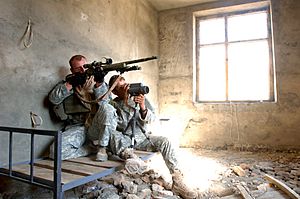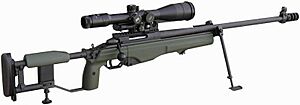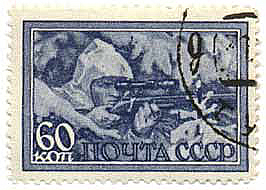Sniper facts for kids
A sniper is a person specially trained to shoot very accurately at small or far-away targets. Their target is usually an enemy. Many military snipers learn to use a sniper rifle, which is a special type of gun. Most sniper rifles have a telescope called a sniper scope to help the sniper see their target clearly. Snipers are also trained to be very good at hiding. They use special military camouflage like a ghillie suit that helps them blend in with the trees and plants around them. This makes it very hard for enemies to see them. Another name for a sniper is a "marksman."
Experienced hunters often have many skills similar to snipers, especially when shooting from far away. The word "sniper" comes from Britain. It was used for highly accurate shooters who hunted birds called "snipes," which were very hard to see and shoot.
Many police departments have snipers on their SWAT teams. Police snipers sometimes have different jobs than military snipers, so they are also called "marksmen."
Contents
Sniping Skills
Snipers shoot targets that are very far away. Because the bullet travels a long distance, the sniper must be very careful when aiming. Three main things can affect how accurate the shot is. Snipers must plan for these:
- A target might be moving, like walking or running. A sniper has to guess where the target will be when the bullet gets there. Even a still target might suddenly move.
- Gravity pulls the bullet downwards. If the target is close, gravity doesn't affect the shot much. But if the target is far away, the sniper must aim higher to make up for how much the bullet will drop as it flies.
- Wind can push the bullet away from the target. The sniper must think about the wind's direction and how strong it is. They might need to aim a little to the left or right of the target to account for the wind.
Snipers usually use heavy bullets. These bullets have a lot of gunpowder to make them travel very fast. Heavy bullets are less affected by wind. Fast bullets are less affected by gravity because they reach the target quicker. Large, fast bullets also do more damage than lighter or slower ones.
Accuracy in Shooting
Most soldiers are trained to hit a target about 200 to 300 meters (650 to 980 feet) away with about half their shots. Very well-trained soldiers, like the U.S. Marine Corps, can hit a target 400 to 500 meters (1,300 to 1,600 feet) away with about half their shots. A sniper is trained to hit a target over 800 meters (half a mile) away with almost every shot. Some snipers are so accurate they could shoot something out of a person's hand! However, they usually aim for the target's head or chest. These areas are larger and more likely to stop the target.
Sniper Rifles
A sniper uses a special kind of gun called a sniper rifle. This rifle is much more accurate than regular rifles. Almost all sniper rifles use a Sniper scope. This special telescope lets them see targets that are very far away. There are two main types of sniper rifles:
- Bolt-action rifles: These fire one shot, and then the shooter must manually prepare the next shot.
- Semi-automatic rifles: These fire one shot each time the trigger is pulled.
Bolt-action rifles usually shoot farther and are more accurate than semi-automatic rifles. However, they fire slower. Semi-automatic rifles fire as fast as the shooter can pull the trigger. For close targets or when a quick second shot is needed, a sniper might prefer a semi-automatic rifle. Many rifles use a magazine, which holds more bullets and makes reloading faster.
Camouflage and Hiding
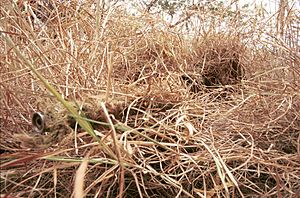
Snipers often wear camouflage clothing to avoid being seen. Camouflage works by breaking up the outline and shape of the human body, making it hard to spot. Camouflage doesn't work well when a person is moving, because our eyes notice movement easily. Snipers often paint their faces green or black to make them shine less and blend in with their surroundings.
Sometimes snipers wear special camouflage suits called ghillie suits. These suits are made of shredded fabric and often have plants attached to them. Snipers might make different ghillie suits to hide in different types of terrain. These suits are very good at hiding the sniper. Sometimes, a sniper can be almost invisible to an enemy standing very close by.
Police snipers usually don't need camouflage as much. Their main job is to make accurate shots, not always to hide from criminals. However, police snipers are still trained in hiding techniques for situations where they do need to be unseen.
Snipers in War
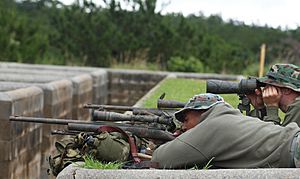
Military snipers are chosen for being smart, having excellent eyesight, and being very good at shooting. They are trained to use their sight very well. They learn to spot enemies from far away and notice small movements that might show enemies are near. They are also trained to hide themselves perfectly. Snipers use these skills to help their army.
Snipers usually work in a small team of two people: a sniper and a spotter. The spotter uses a telescope to find targets for the sniper. If the sniper misses, the spotter helps them adjust the next shot to hit the target. The spotter also protects the sniper from enemies who get too close.
Snipers are often used as scouts for the army. They can easily hide from the enemy, even when they are close. They use their sniper scope to see farther than most soldiers. Snipers are often good at noticing details and remembering information that other soldiers might miss. When a sniper is with a spotter, the spotter usually uses a radio to talk to other military units. The team can report on where the enemy is and what they are doing.
Snipers in World War I and II
In World War I (WWI), there were no special sniper rifles. Snipers used regular rifles with a sniper scope attached.
In World War II, snipers became very common and important in battles. Every squad in the Soviet army often had a sniper or a 'marksman'. New camouflage methods were developed during this time. Snipers were very useful during the Battle of Stalingrad. One Russian sniper, Vasily Zaytsev, was said to have killed over 240 German soldiers. Other snipers had even more kills, like Mihail Surkov (702 enemy troops) and Semen Nomokonov (367 kills, including a general). Simo Häyhä, known as "the White Death," has the most confirmed kills of any sniper in history.
Police Snipers
Police departments also train and use snipers. These snipers mainly work with the SWAT team for their department. They are often called to provide security at special events or to make sure other snipers don't harm anyone. This job is called counter-sniping. Most police snipers are trained by the military.
Famous Snipers
Some snipers are famous for their amazing skills. One such sniper is U.S. Marine Corps sniper Carlos Hathcock. He was famous in the Vietnam War for wearing a white feather in his hat. Carlos Hathcock held the record for the longest distance kill for a very long time – his farthest shot was over 2,500 yards (2,286 meters). However, in the Afghanistan War, snipers from the Canadian Army broke that record with a shot of 2,430 meters (2,657 yards). Other snipers are known for making very difficult shots. For example, Matt Hughes made an 860-meter (2,820 feet) shot in very strong winds by aiming over 56 feet (17 meters) to the left of the enemy.
Snipers in Popular Culture
Snipers are often shown in video games as elite soldiers. Getting a "headshot" with a sniper rifle is seen as a difficult skill to learn in games. In some movies, characters use sniper rifles; examples include Phone Booth and Vantage Point. Sometimes snipers are shown in a negative way in the media.
Related pages
Images for kids
-
Vasily Zaytsev, left, and other Soviet snipers equipped with Mosin–Nagant M1891/30 during the Battle of Stalingrad in December 1942.
-
A modern sniper weapon system which consists of a sniper rifle (here Barak HTR 2000 chambered in .338 Lapua Magnum), telescopic sight (Leupold Mark IV x10), and additional optics.
-
A U.S. Army sniper using a Barrett M82.
-
A U.S. Army sniper team from Jalalabad Provincial Reconstruction Team (PRT)
-
YAMAM (Israel's counter-terrorism unit) sniper shooting with suppressed Barrett MRAD sniper rifles
-
A US Secret Service sniper on the roof of the White House
-
Frederick Russell Burnham in Africa
-
An Australian sniper aims a periscope-equipped rifle at Gallipoli in 1915. The spotter beside him is helping to find targets with his own periscope.
-
German sniper in Stalingrad, Soviet Union (1942)
-
A British sniper in Gennep, Holland, 14 February 1945.
-
Canadian Sniper during World War II.
-
A U.S. Marine sniper wearing a ghillie suit.
-
Two Israel Defense Forces snipers (one serves as the shooter and the other as a spotter), armed with the "Barak" (H-S Precision Pro Series 2000 HTR) sniper weapon system, during sniping contest.
-
Bundeswehr sniper team in position, Kunduz Province, Afghanistan
-
Sergeant H.A. Marshall of The Calgary Highlanders. Canadian snipers in the Second World War were trained scouts. Specialized equipment includes Lee–Enfield No. 4 Mk I(T) rifle and scope combination and a camouflaged Denison smock. PAC Photo, by Ken Bell (September 1944).
-
Carlos Hathcock, nicknamed "White Feather" by the North Vietnamese Army (NVA), was a legendary USMC sniper with a service record of 93 confirmed kills.
See also
 In Spanish: Francotirador para niños
In Spanish: Francotirador para niños


